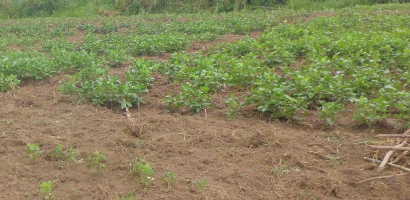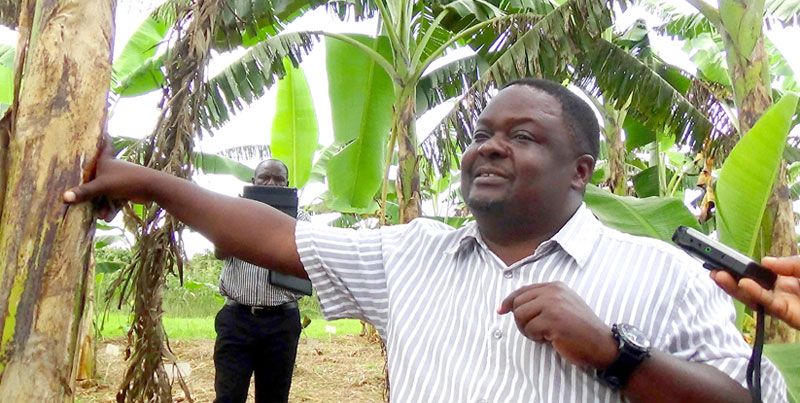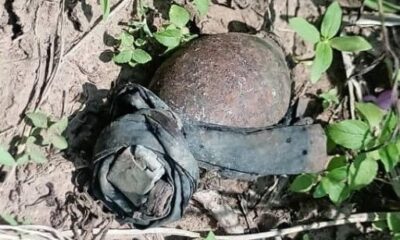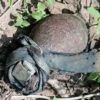Greengrams; a drought resistant substitute for beans

IMPRESSIVE: At this NaSARRI field experiment, In the foreground, beans appear baked by the recent prolonged dry spell. In stark contrast, greengrams, in the background, thrived and managed to put on pods
But due to challenges posed by climate change such as prolonged dry spells, bean producers are facing more challenges arising from harsh weather conditions.
Scientists have however discovered that Greengrams, known as Choloko in Eastern Region where they are commonly grown, can withstand drought much better than ordinary beans grown in central and western parts of the country.
In an experiment at the National Semi-Arid Resources Research Institute (NaSARRI) in Serere, Scientists have succeeded in showing that Choloko does better than beans during periods of water scarcity.
A field experiment showing performance of greengrams and beans against drought conditions that is being carried out by NaSARRI scientists has clearly shown that greengrames – certainly a less known legume in Central and Southern parts of Uganda but known as Choloko, in the eastern parts, beats beats by far when it comes to withstanding water scarcity brought about by scotching sun.
As Robert Amayo, the Head of the Dryland Legumes Programme at NaSARRI, narrated, they were excited to see greengrams progress into flowering and even bearing fruits, during last month’s very dry conditions.
“We planted the two legumes; greengrams and beans at the beginning of May. And for the rest of the month, we received no rain. We were excited however, to see that greengrames thrived where beans have failed. As you can see, beans have been scorched, but greengrams are lush,” Amayo sad while pointing to the field trial, [shown in photo above].
Emmanuel Mbeyagala, the plant breader in the Dryland Legumes programme at NaSARRI told a group of visiting journalists doing a fellowship with Biosciences for Farming in Africa (B4FA) that their research has proved that Greengrams can grow in drier conditions.
He added that the fact that the legume can thrive in other parts of the country is a big source of hope that Ugandans have a crop that can help cushion families against the effects of drought.
NaSARRI scientists however acknowledged that early shattering of dried pods in greengrams has limited their commercialisation in Uganda. Because of this handicap, scientists are trying to cross different varieties of greengrams in the hope of getting one that shatters less. Using convetional breeding means like crossing, they are trying to select greengrams that produce pods above the canopy. They are also looking for varieties whose fresh pods can be eaten as fresh vegetables the way french beans are.
Major handicap
NaSARRI scientists however expressed deep frustration about the lack of modern research facilities that would enable them to accelerate the discovery of varieties with the desired characteristics.
For instance, in the absence of modern research laboratories, most researchers say they are left with no option but to use convetional techniques especially crossing of planted varieties, that are time consuming.
As Amayo noted, if only they had modern plant breeding facilities, they would be able to identify the desired characteristics much faster and as a result would be able to respond to such challenges as early shattering much faster.
Other programmes
Under the same legumes programme, the scientists have also developed a faster maturing variety of pigeon peas (Enkolimbo in Luganda), which can supplement families protein needs but also withstand dry spells because of its hardy nature.
According to Mbeyagala, the scientists have successfully tried a new variety of Pigeon Peas that can mature in 70 days compared to the traditional variety that matures in 120 days and beyond.
Mbeyagala adds that they are trying to collaborate with private companies to develop composite foods from green grams for added nutritional advantages for children, pregnant mothers who need special enhanced foods. He said for example that if green grams are added to flour made from cow peas or pigeon peas, they can make protein-enriched products crunches like Bagiya and hence help to improve the uptake of proteins.
Composite foods are made from mixing of different processed food. In Uganda, several companies like Maganjo grain millers are producing composite foods by mixing rice, maize, oats and millet flours to make highly nutritive porridge substance.
Comments

























